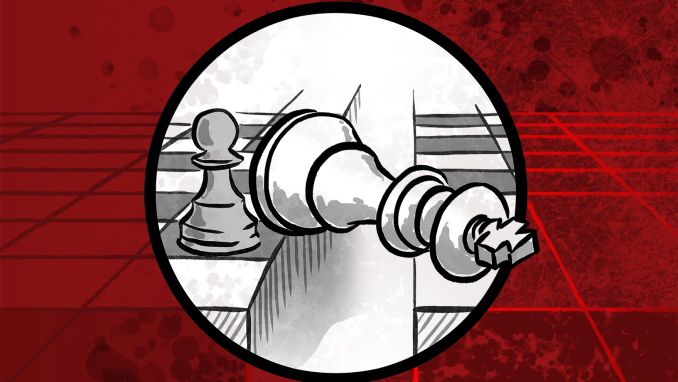
The following is an excerpt from the book Fail to Learn by Scott Provence, and has been reproduced here by kind permission of the author.
Fail to Learn: A Manifesto for Training Gamification is available from Amazon
“Press the green button to pick up the gun.”
“No, the green button.”
“Green button.”
I had never played a first-person shooter before. In fact, it was quickly becoming clear that I’d barely picked up a video game controller. My younger brother Collin, on the other hand, was a gaming pro. So I sat and listened carefully to his patient instructions over the phone. We were about to head into battle, and it was his job to help me survive.
But I was still the older brother, and I hated looking dumb in front of Collin. So I insisted the first game we play be something he’d never tried before either.
The game started, and our avatars were suddenly in the virtual wilds of Northwestern America. It was a fitting location since the two of us were separated by the actual wilds of Northwestern America. Say what you will about technology, but it’s certainly made online cooperative gaming a breeze.
Yet, despite this high-tech platform, I still couldn’t figure out how to make my avatar pick up his stupid gun.
“Someone’s coming.” Collin’s voice came through my earpiece, as I caught the blur of movement on my screen.
I gave up on the gun and steered my avatar behind a large crate. I’d seen the previews for this game. I knew it was going to get bloody.
“Are they out there?” I realized a second too late that I was whispering into my headset, as if the bots in the game could hear me.
“Dunno. Hang on a minute.”
I watched Collin’s character glide past me. He conjured up a ridiculously large rifle out of thin air, then he ducked out the door.
BANG!
“Yup,” Collin said, unfazed after experiencing what I could only imagine was a quick and gruesome death. “There’s an ambush waiting for us out front.”
I froze, both onscreen and in real life. This game actually pumped in heartbeat sounds over the audio track. As if it wasn’t enough to feel my own heart in my throat.
All of a sudden, I saw Collin run past me again.
“Wait, I thought you just died,” I said.
“Instant respawn, man. Hang on a minute.”
He poked his head out the door again.
BANG!
“Dang it. Okay, going left might not be an option.”
I thought I saw a bullet flash above my crate. I tried to make my avatar crouch down even lower. Meanwhile, Collin breezed by me for a third time.
BANG!
“Yeah. Definitely don’t go left.”
“How many lives do we get?”
“Lives? Infinite.” Collin said, as if confused by the question. He raced by me once more. He was moving faster this time, already getting familiar with the game’s controls.
“What should I do?” I asked, spinning my crouched character in a desperate circle.
BANG!
“Come join me this time. No? Well then I’ll just—”
BANG!
“Oh, I see what they’re doing now. Maybe we should try—”
BANG!
I risked a glance over the top of my crate. Collin was already out front for a seventh time, guns blazing. His avatar looked close to death (again), but he also looked like he’d gotten even farther away from our starting point.
BANG!
This time a bullet hit me. My screen flashed. “Am I dead?” I shouted. “Where are you going? You’re supposed to help me survive!”
By the time I finally poked my head out the door, all the bad guys were gone and Collin’s character was waving to me from the top of the hill.
“Here’s a survival tip,” he said. “Try dying.”
DEATH AND PERMADEATH
In 2014, the “Golden Joystick” award for Best Game of the Year went to an action role-player called Dark Souls II. In addition to the sweeping journey Dark Souls II took players on, it also gave some great behind-the-scenes data. We got to see how often players of Dark Souls II died.
Adding up just the Dark Souls console gamers (e.g., people who played on PlayStation, Xbox, etc.), people were dying in this game a whopping 150,443 times per hour, which equates to 42 deaths every second.
That means, in 2014, the death rate in Dark Souls II was 23 times higher than the actual death rate in the real world.
In order to beat Dark Souls II on PlayStation 3, a player died 860 times on average.1 That’s a failure-to-success ratio most of us would be comfortable with in the “real world.”
I’d say I have a healthy fear of death. It keeps me from base-jumping and lion-taming, but it also apparently keeps me from developing any skills as a game-player.
Death is one of the most common learning mechanisms in games. From the classic chess board to the zombie hordes of Resident Evil, games help us learn by killing us over and over again. Your average gamer expects to die in nearly everything they play. To them, death and rebirth is just a dressed-up version of trial and error.
It’s usually only the very experienced gamers who seek challenges without a “respawn” option. In these rare environments, if you die, you’re done. No do-overs. No refresh from the last save-point. In the gaming world, it’s known as “permadeath.”

Even for experienced video gamers “permadeath” can be an agonizing thing to experience. Just ask Phil Watson, who holds the world record for longest survival time in “Hardcore” mode of the video game Minecraft. This mode combines all of the most difficult game settings, along with a permadeath state, meaning if you die, you lose the entire world you’ve built.
Some of the best Minecraft Hardcore players are able to survive for a few weeks. Phil Watson lived in his Minecraft world for five years.
It made his character’s demise all the more tragic. A video of Watson’s last fateful seconds (which occurred in April 2019) has over a million views online. In it, you can hear the anguished cries that lie at the heart of any permadeath scenario:
“Noooo!! Really?! That’s how I die?”2
KILL THE MONKEY
When it comes to dealing with death, I’m somewhere between my little brother and Phil. To be honest, I’m probably closer to Phil, in the sense that I felt like screaming and pulling my hair every time I messed up in a game. The same applies to all the times I failed in the classroom.
Games are helping me change that perspective, and become a better learner (and facilitator) because of it.
One of the things games do to help me (and the millions of other loss-averse people out there) is to actually make failing an enjoyable, even funny experience.
Picture this: You’re a monkey trapped inside a glass ball. You need to get from one side of a platform to the other. You pedal desperately through different speeds and slopes, and more often than not, you roll off the platform into the dark abyss below. You scream your high-pitched monkey scream all the way down.
This is the general premise of the game Super Monkey Ball 2. Like all games, you’d assume players would be most interested in beating levels and completing the game.
You’d be wrong.
Psychologists in Finland had a group of people play Super Monkey Ball 2 while hooked up to biosensors. They wanted to see at which point in the game people experienced the biggest spikes in physiological activity.
When players achieved the set objectives of each level, their pleasure increased. When they missed an objective, their frustration increased. No surprises so far.
But then the researchers noticed something weird happening. When players deliberately tried to fail—when they purposefully sent the poor monkey spinning off into space—they registered not frustration or boredom, but pleasure. “Although the event in question represents a clear failure, several physiological indices showed that it elicited positively valenced high-arousal emotion (i.e., joy), rather than disappointment.”3
I’ll admit, there’s something innately pleasurable about sending a tiny cartoon monkey screaming into the void. The researchers concluded that negative events in a game can still elicit positive emotional responses. Ultimately, they found that attaining the game’s original objectives actually decreased a player’s level of interest overall.4
Sometimes, it’s just more fun to kill the monkey.

EMOTIONAL RESILIENCE
Let’s face it: most of us have pretty fragile egos when it comes to learning something new. No one likes being the unskilled novice. Making a mistake doesn’t often feel good. In fact, some of the studies that show the benefits of error-driven learning are quick to point out that it only works “if students have the emotional resilience to respond to mistakes adaptively and flexibly.”5
In other words, learners have to feel secure enough and brave enough to lose. So what is the best way to create a flexible, emotional resilience to making mistakes?
Play a game.
“Despite the societal taboo against failure,” one educator writes, “there is one place where it is expected and embraced – games. In particular, video games are built on the premise that progress happens through a process of experimentation, failure, and adaptation.”6
Studies conducted by everyone from the American Psychological Association to Columbia University found the same thing.7 Those who played games tend to be more emotionally resilient than those who do not. Some studies even found that video game players showed “significantly higher intellectual functioning, higher academic achievement, better peer relationships, and fewer mental health difficulties.”8
A lot of this emotional resilience can be traced back to the fact that game-players can build up a bigger-picture perspective about failure. They get used to telling themselves “it’s all just a game.” And slowly, those fragile egos become tempered through the process of playing, until they have the steely resolve to sustain just about any error in real-life.
Games give us “a kind of lightness and freedom,” educator and designer Jesper Juul explains. The reason we’re okay with failing so often in games is because “we have the option of denying that game failure matters.”9 And the more we play, the more we can bring this perspective to all other parts of our life.
Fail to Learn: A Manifesto for Training Gamification is available from Amazon
Read Scott’s other article for Ludogogy where he explores the idea that not all failure is created equal.
References and further reading:
1 Crawley, Dan. “42 Dark Souls II players die every second – and nine other chilling stats.” Venture Beat, 25 April 2014, venturebeat.com/2014/04/25/42-dark-souls-ii-players-die-every-second-and-nine-other-chilling-stats/
2 Harbison, Cammy. “’Minecraft Hardcore’ streamer loses 5-year world record in a most unfortunate way.” Newsweek, 30 April 2019, www.newsweek.com/minecraft-hardcore-world-record-broken-philza-phil-watson-death-five-year-run-1410286
3 Thompson, Clive. “The Joy of Sucking.” Wired, 17 July 2006, www.wired.com/2006/07/the-joy-of-sucking/
4 Sparks, Matt. “Metafocus: Well-designed Failure in Serious Games.” Learning Solutions, 26 September 2019, learningsolutionsmag.com/articles/metafocus-well-designed-failure-in-serious-games
5 Eva, Amy. “Why We Should Embrace Mistakes in School.” Greater Good Magazine, 28 November 2017, greatergood.berkeley.edu/article/item/why_we_should_embrace_mistakes_in_school
6 Teach Thought Staff. “How To Help Your Students Embrace Failure Through Game-Based Learning.” Teach Thought, 4 March 2019, www.teachthought.com/learning/help-students-embrace-failure-game-based-learning/
7 Bowen, Lisa. “Video game play may provide learning, health, social benefits, review finds.” American Psychological Association, vol. 45, no. 2, 2014. www.apa.org/monitor/2014/02/video-game
8 Gray, Peter. “Benefits of Play Revealed in Research on Video Gaming.” Psychology Today, 17 March 2018, www.psychologytoday.com/us/blog/freedom-learn/201803/benefits-play-revealed-in-research-video-gaming?amp
9 Juul, Jesper. The Art of Failure: An Essay on the Pain of Playing Video Games. MIT Press, 2016, p. 21. Emphasis mine.
- Die Trying – Learning through Failure in Games - 13th January 2022
- Glass Cliffs and Brick Walls - 9th August 2020





Be the first to comment